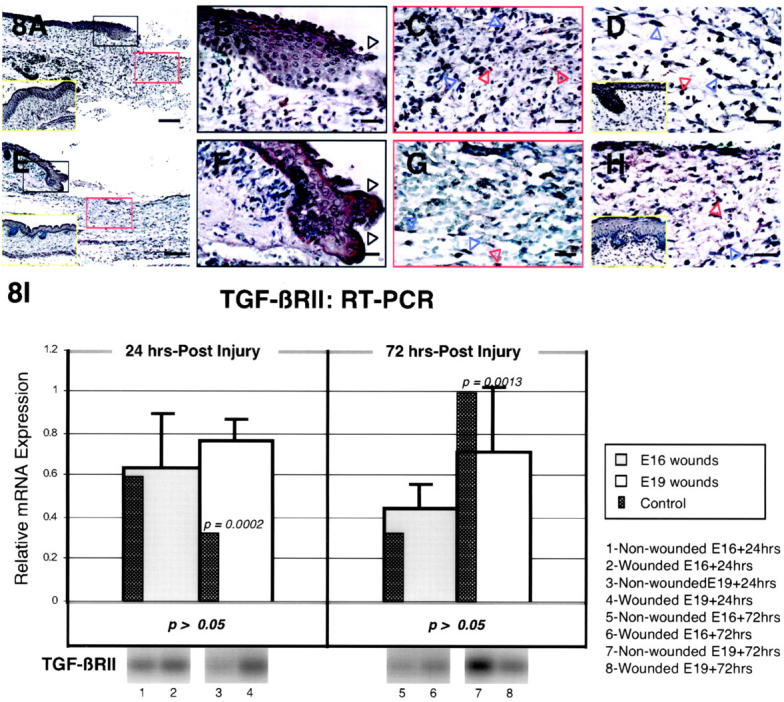Figure 8.

TGF-βRII immunostaining of wounded E16 and E19 rat skin. A: E16 skin, 24 hours post-injury; magnification, ×100. No TGF-βRII up-regulation is observed in comparison with non-wounded E17 [ie, E16 + 24 hours] control skin (inset, A, yellow rectangle). B: E16 skin, 24 hours post-injury; magnification, ×400. Higher magnification view of wounded epidermis demonstrating minimal TGF-βRII staining in outer, basal, and migrating (black open arrows) epidermal layers. C: E16 skin, 24 hours post-injury; magnification, ×400. Minimal TGF-βRII staining is observed in dermal fibroblasts (blue open arrows) as well as inflammatory cells (red open arrows). D: E16 skin, 36 hours post-injury; magnification, ×400. No TGF-βRII staining is observed in dermal ECM and fibroblasts (blue open arrows), whereas moderate staining is seen in inflammatory cells (red open arrow) 36 hours after wounding. Non-wounded E17.5 [ie, E16 + 36 hours] control skin is also shown (inset, D, yellow rectangle). E: E19 skin, 24 hours post-injury; magnification, ×100. Wounded E19 skin demonstrates epidermal TGF-βRII up-regulation in comparison with non-wounded control skin. Non-wounded E20 [ie, E19 + 24 hours] control skin is also shown (inset, E, yellow rectangle). F: E19 skin, 24 hours post-injury; magnification, ×400. Moderate epidermal staining is observed in the migrating (black open arrow) as well as in the outer and basal epidermal layers. G: E19 skin, 24 hours post-injury; magnification, ×400. Inflammatory cells (red open arrow) show minimal TGF-βRII staining whereas fibroblasts (blue open arrows) and dermal ECM demonstrate no staining. H: E19 skin, 36 hours post-injury; magnification, ×400. Dermal up-regulation of TGF-βRII receptor expression is observed solely in inflammatory cells (red open arrow). TGF-βRII receptor staining in fibroblasts (blue open arrow) and the ECM does not differ significantly from control skin. Non-wounded, E20.5 [ie, E19 + 36 hours] control skin (inset, H, yellow rectangle) exhibit minimal dermal TGF-βRII staining. Bars: A and E, 200 μm; B–D, F–H, 50 μm. I: RT-PCR of TGF-βRII. Please refer to the Figure 4Ic ▶ legend for an explanation of the bar graphs and representative Southern blot data.
